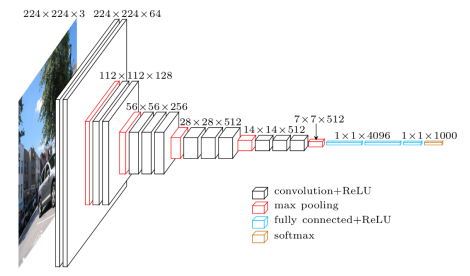
Open-Source Internship opportunity by OpenGenus for programmers. Apply now.
VGG16 is a variant of VGG model with 16 convolution layers and we have explored the VGG16 architecture in depth.
VGGNet-16 consists of 16 convolutional layers and is very appealing because of its very uniform Architecture. Similar to AlexNet, it has only 3x3 convolutions, but lots of filters. It can be trained on 4 GPUs for 2–3 weeks. It is currently the most preferred choice in the community for extracting features from images. The weight configuration of the VGGNet is publicly available and has been used in many other applications and challenges as a baseline feature extractor.
However, VGGNet consists of 138 million parameters, which can be a bit challenging to handle. VGG can be achieved through transfer Learning. In which the model is pretrained on a dataset and the parameters are updated for better accuracy and you can use the parameters values.
16 layers of VGG16
1.Convolution using 64 filters
2.Convolution using 64 filters + Max pooling
3.Convolution using 128 filters
4. Convolution using 128 filters + Max pooling
5. Convolution using 256 filters
6. Convolution using 256 filters
7. Convolution using 256 filters + Max pooling
8. Convolution using 512 filters
9. Convolution using 512 filters
10. Convolution using 512 filters+Max pooling
11. Convolution using 512 filters
12. Convolution using 512 filters
13. Convolution using 512 filters+Max pooling
14. Fully connected with 4096 nodes
15. Fully connected with 4096 nodes
16. Output layer with Softmax activation with 1000 nodes.


